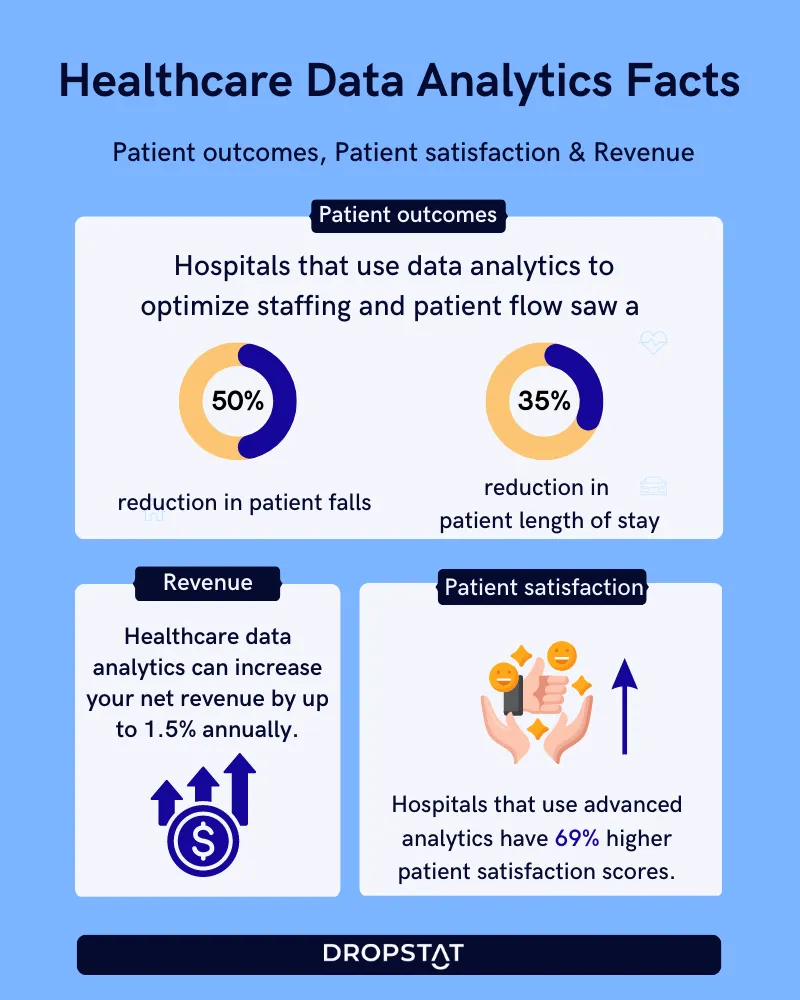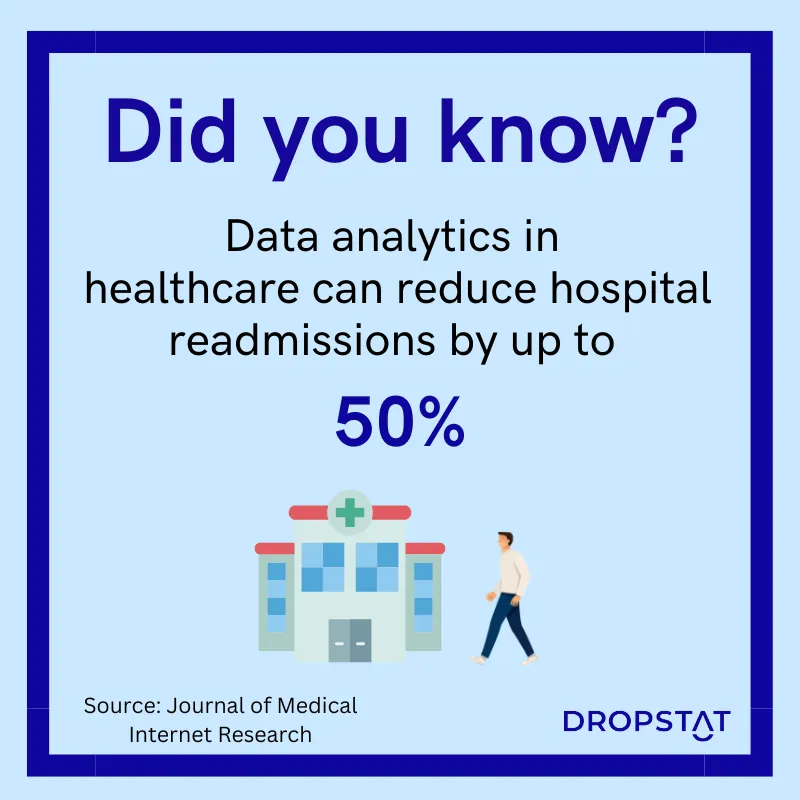How is data analytics typically used in healthcare settings?
Numerous aspects of healthcare can be enhanced through the use of healthcare data analytics. Here are a few examples:
- Clinical decision-making
- Patient satisfaction
- Patient and staff scheduling
- Financial forecasting
Clinical decision-making
Data analytics can help clinicians make informed decisions by providing insights into patient outcomes and identifying effective treatments for different conditions.
Improving patient satisfaction
Healthcare organizations can use data analytics to gain insights into patient behaviors and preferences and develop personalized engagement strategies that improve patient satisfaction and outcomes.
Improving scheduling and administrative tasks
Inefficient administrative and scheduling methods contribute to wasted resources and inefficiencies that reduce patient satisfaction and safety. However, healthcare organizations can improve patient outcomes by using healthcare data analytics to determine and fix core issues such as excessive patient wait times or high readmission rates.
Financial forecasting
Financial forecasting in healthcare involves using financial data and analysis to predict future financial performance and make informed decisions about budgeting, resource allocation, and investment strategies. It involves projecting future revenues, expenses, and profits based on past performance and current trends in the healthcare industry.

The goals of healthcare data analytics
The healthcare industry requires comprehensive approaches to understanding the challenges of its current practices and the systems that can enhance them. Implementing analytics tools within your facility enables your healthcare teams to improve efficiency within their operations. However, it is crucial to determine which data analytics techniques will be the most valuable for generating actionable insights.
The four different types of healthcare data analytics are:
- Descriptive Analytics
- Diagnostic Analytics
- Predictive Analytics
- Prescriptive Analytics
Descriptive analytics in healthcare can be used to understand the challenges and successes of a facility. Diagnostic analytics can help to reveal the reasons or causes that contribute to those outcomes. Additionally, predictive analytics is implemented to forecast future scenarios based on previous clinical data. Lastly, prescriptive analytics offers recommendations that healthcare facilities can integrate into their practices to improve patient care and outcomes. Refining health information management is a critical component of increasing patient safety.
6 ways to improve patient safety and outcomes with data analytics in healthcare
Value-based care that prioritizes patient safety and satisfaction should always be at the forefront of every healthcare organization. By utilizing data analytics, your institution will improve coordination that directly impacts patient outcomes.
A few ways to integrate healthcare data analytics within your current procedures include:
- Developing more efficient appointment scheduling methods
- Predicting specific hiring needs and nursing roles
- Decreasing readmissions
- Preventing secondary infections by determining risk factors
- Predicting patient volumes to schedule nursing staff accordingly
- Reducing nurse overtime to provide more attentive clinicians

- Appointment scheduling
Relying on healthcare data analytics to enhance patient scheduling enables providers to understand what factors may lead to inefficiencies. For example, recognizing the times of day that typically experience frequent late patients can lead to budgeting for longer buffers between appointments rather than pushing the next patient’s appointment to a later time or another day altogether. Better appointment scheduling ensures that patients see their clinicians when needed, improving patient care and safety.
2. Predicting hiring needs
Data analytics can also be used to predict hiring needs by evaluating previous employee data and trends that can illuminate future staffing shortages. Suppose your facility experiences short staffing or resignations during particular times of the year or week. In that case, healthcare analytics can give organizations insight into these trends that will allow administrators to hire the right candidate and fill the staffing shortage based on unique organizational data.
3. Decreasing readmissions
High readmission rates indicate a need for more quality patient care which will decrease avoidable healthcare spending. Healthcare data analytics can be used to discover which factors typically lead to readmissions to improve clinical outcomes. Furthermore, industry regulations and the Hospital Readmissions Reduction Program (HRRP) have specified methods that can be instituted to reduce readmissions by assisting with better care coordination and focusing on value-based care.
4. Determining employee risk factors to prevent short staffing
Healthcare data analytics can be implemented to identify which behaviors and workplace experiences typically lead to reduced employee satisfaction and turnover. For example, requiring your nursing staff to work overtime to fill staff shortages may interfere with their work-life balance and personal responsibilities. However, using healthcare data analytics to detect risk factors and prevent these situations helps ensure that facility operations do not contribute to short staffing. Ultimately, reducing the occurrence of short staffing leads to better patient safety and health outcomes.

5. Predicting patient volumes
Healthcare data can also determine patterns in patient volumes which can help healthcare providers make data-driven decisions about their staffing needs and patient demands. For instance, being able to forecast which days of the week or times of the year typically experience higher patient volumes (such as holidays and times with extreme weather conditions) allows schedulers to preemptively staff more nurses to guarantee safe nurse-patient ratios based on past hospital data. Enabling schedulers to make staffing decisions based on experience and insight ensures better patient safety and less stressful scheduling practices.
6. Reducing nurse overtime
Similar to predicting patient volumes, understanding which shifts consistently need more staff helps schedulers prevent nurses from working overtime. By reducing overtime, nurses can maintain a better balance between personal and professional responsibilities alongside taking time to invest in positive mental health practices such as sustaining proper sleep habits. These routines decrease compassion fatigue and ensure patients are treated by the most vigilant staff, supporting patient safety while diminishing overtime costs.
Dropstat uses healthcare data analytics features to enhance facility efficiency and improve patient safety.
Given that the healthcare industry is a dynamic environment, data analytics can help support efforts to implement more evidence-based operations that promote greater efficiency within your facility and lead to better patient safety procedures. The main features of Dropstat that can help your institution achieve these goals include the ability to predict staffing needs up to 2 months in advance and the capacity to detect when a nurse goes into overtime by picking up a shift.
Allowing schedulers to recognize staffing needs prior to short-staffing crises helps ensure that safe nurse-patient ratios are always in compliance with safety regulations. Guaranteeing safer staffing also contributes to better employee satisfaction which reduces turnover.
Additionally, determining which staff will be in overtime by picking up a shift is a major component in providing high-quality patient care and reducing the likelihood that nurses will make errors due to being overworked and overtired. Schedule a demo now to start implementing these core preventative data analytics strategies through Dropstat and decrease the prevalence of unsafe patient care and inefficient operations.







